50c Queensland fare guide: All your questions answered
The Courier-Mail has created a guide with everything you need to about the 50c fare initiative kicking off on August 5.

QLD News
Don't miss out on the headlines from QLD News. Followed categories will be added to My News.
With 50c fares just around the corner, there are bound to be questions about what will change to Queensland’s public transport system. The Courier-Mail has created a guide with everything you need to know to make the most of the 50c fares initiative.
When will it start?
From Monday 5 August, fares will be reduced to a 50c flat rate across all zones and modes on the TransLink network across Queensland for a period of six months.
What public transport modes included?
This will include all regional urban buses, and bus, train, ferry, tram and on-demand services in South East Queensland. While this won’t apply to Airtrain fares, they will be reduced, with tickets starting from $10.95. Airtrain fares will only be reduced to $10.95 when travelling from all Brisbane City stations to the Brisbane Domestic and Brisbane International stations. Brisbane City stations include Eagle Junction, Wooloowin, Albion, Bowen Hills, Fortitude Valley, Central, Roma Street, and South Brisbane.
TransLink increased patronage plan?
Preparations are underway to deal with capacity increases, TransLink confirmed a TransLink Operations Centre that monitors the network 24-7 will ramp up during the 50c fares trial. TransLink is working closely with delivery partners to use the Rail Management Centre and Brisbane Metropolitan Transport Management Centre to monitor the network. A day-of-operations situation room is being established to closely monitor all aspects of the network during the trial. Locally-manufactured rail replacement buses will be available for deployment.
Can I use cash?
The SEQ network will remain cashless, but Go Cards can be topped up at fare machines located at bus and train stations, or at participating retailers.
Discounts and concession cards?
The 20 per cent discount on off-peak travel and 50 per cent concession fares will not apply during the initiative. All travel across zones and times of day will be a flat rate of 50 cents.
Senior concession card holders will be able to continue to travel free on Brisbane City Council buses and in the Gold Coast City Council areas during off-peak travel times. Children aged five to 14 will continue to travel free on weekends if they use their child Go Card but kids aged four and under will still be able to travel for free at all times.
Parking?
Park ‘n’ ride facilities will continue to be available, allowing customers to park their vehicles and take public transport to complete their journey. Train station carparks are managed by Queensland Rail. Some bus and ferry terminals have carparks managed by Brisbane City Council. TransLink confirmed they meet regularly with delivery partners to work through any concerns and work is also underway to identify potential additional parking options for commuters. To check if your desired train station has parking, Translink’s web page shows the number of spots available at each Park ‘n’ ride carpark.
Increased patronage?
Back on Track spokesman Robert Dow said both bus and train lines will be more crowded by the inevitable usage increase, but there will be ways to navigate that issue.
“Some of the longer distance journeys will be heavily used because it’s so cheap compared to what normal fares are now. One line in particular, that I think will be very busy is the Gold Coast train line, and they could be overloading on the peak,” Mr Dow predicted.
“That is where that service capacity tracker will come in handy for people to check if the service they’re going to catch is heavily loaded or not.
“Using the tools available, like Translink’s service capacity tracker and journey planner are helpful.”
Will the bus or train be busier?
Mr Dow said the rail system will have more capacity than buses and recommended patrons should opt for the train to avoid bus congestion.
“If you have got the option, I would go for the train than the bus,” Mr Dow said.
“Trains are unlikely to get to the point where you cannot get on because they are crowded. You will more likely have an enjoyable journey.”
Do I still need a Go Card?
Mr Dow advised passengers to invest in a Go Card before they begin travelling on public transport. On trams, ferries and trains, you can pay with bank cards or tap with your phone. On buses a Go Card or a pre-purchased paper ticket is required.
“Customers on a tram or train don’t really need a Go Card if they’re prepared to use their credit card. But the only thing is they must touch on touch off with the same credit card to avoid a fine,” Mr Dow said.
The TransLink website would be revamped ahead of the initiative with more information for new people who want to begin making the most of public transport.





